Last updated on March 22, 2024

Plummet | Illustration by Alix Branwyn
Hello fellow Limited players! Today I'll be delving into the lost art of sideboarding in Limited. I say “lost” because Ranked Limited on Arena is BO1, which may have left some players a bit uneasy with 40-card sideboarding.
But BO3 still matters, mostly because competitive Limited events like the Arena Open require you to play BO3 on Day 2. This is a skill you’ll need to pick up if you want to compete at high-level Limited Magic.
Don’t worry, this guide will be your Delver's Torch illuminating all the hidden strategical crevices of BO3 Draft and Sealed games!
Sideboarding in Limited vs. Constructed

Pacifism | Illustration by Kev Walker
The very basics of sideboarding is that you're able to “sideboard” in between games for game 2 and 3. This means you can take cards out from your deck and exchange them with any of the cards in your pre-made sideboard. Sideboarding allows you to better adjust your strategy and card choices to match what you’ve seen and expect from your opponent.
In Constructed Magic, you prepare a 15-card maximum sideboard to accompany your 60-card deck. On the other hand, a Limited main deck is 40-cards minimum while your sideboard is the rest of your Draft/Sealed pool. Limited sideboards also always include an infinite number of basic lands so you don’t need to worry about opening or drafting certain basics to add a splash or switch colors (or decks; more on that later) between games.
What is a “Sideboard Card”?
If you’ve played Magic for a bit, you’ve almost certainly heard the term “sideboard card” used to describe something. There’s nothing wrong with this label as it does readily describe a certain kind of card. The typical sideboard card is a specialized answer to a certain color or class of permanents with little to no proactive value beyond efficiently answering certain game objects and plays. Some recent examples of this would be Crushing Canopy, Return to Nature, and Ray of Frost.
These cards are rarely good to start in your 40 because their value is entirely based on whether or not your opponent plays certain kinds of cards. Plummet could rot in your hand all game game 1 against a Gruul () opponent in Draft.
Using this class of card is level 0 of sideboarding; if your opponent kills you with flyers and Glorious Sunrise game 1, you don’t have to be Jon Finkel to figure out that Crushing Canopy is worth boarding in!
Everything is a Sideboard Card!
But this is only the beginning to your understanding of a “sideboard card,” because I’m going to blow your mind for a second: every card is a potential sideboard card!
An extra copy of Pointed Discussion can come in against your opponent’s sluggish Dimir () deck, and that Grisly Ritual you begrudgingly took can answer their Toxrill, the Corrosive. You can trim your two Wretched Throngs for these cards since they can’t attack well into your opponent’s bigger creatures and your mana curve are less important in this game.
Against your Selesnya () opponent next round, two copies of Steelclad Spirit can come in on the draw and shore up your early game against your opponent's aggressive deck with several copies of Dawnhart Disciple. Because you're on the draw against a deck with a weaker late game than yours, trim a Pointed Discussion and a Repository Skaab for leaner, cheaper cards to protect yourself. Leave in your two copies of Scattered Thoughts since cutting all your card draw would leave you unable to leverage your blockers for a smooth transition to late game.
Cards Not to Cut
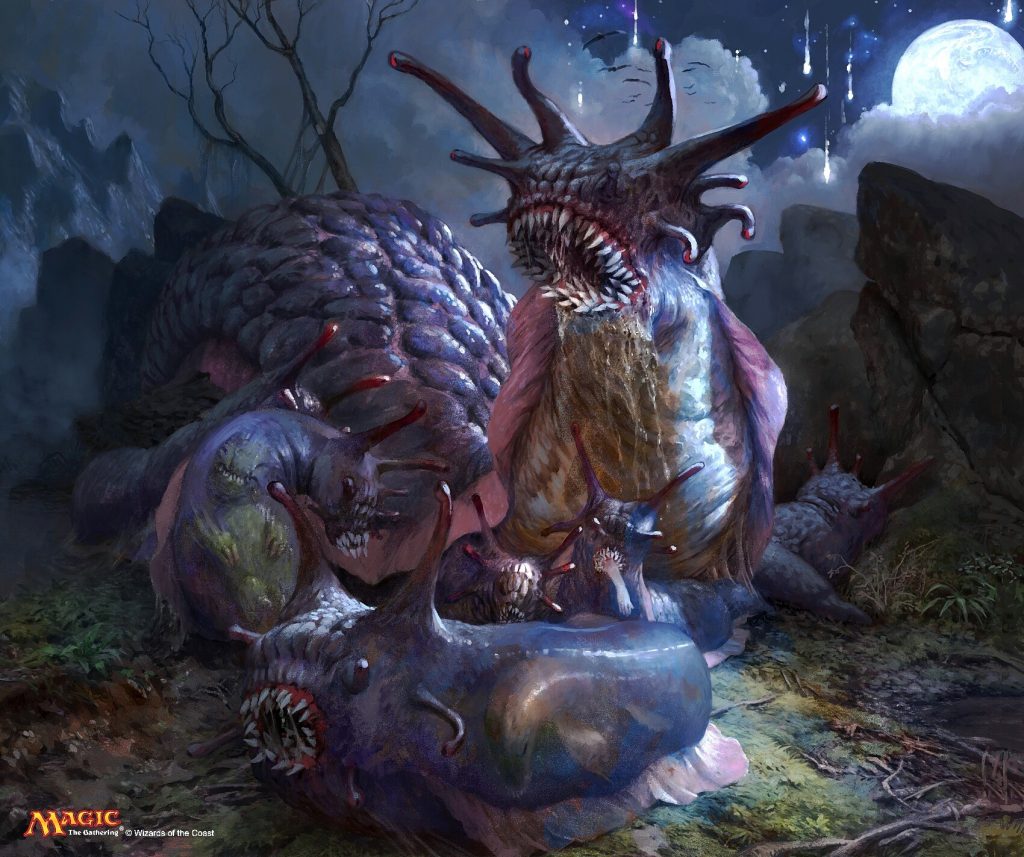
Toxrill, the Corrosive | Illustration by Simon Dominic
While a lot of cards can potentially be on the chopping block if you know exactly what you're doing, here are some general cards I almost never cut:
- Bomb rares. Even against aggressive decks, a card like Dreadfeast Demon and Toxrill, the Corrosive can still be an amazing win condition. My focus instead is on removing expensive but less impressive cards rather than saying “7 is just too much” and giving up on them.
- Premium removal spells. Even if you don’t see any amazing targets, Bleed Dry is just too efficient to board out in most matchups. Grisly Ritual, on the other hand, is a great example of a card that moves in and out a lot based on the matchup.
- Archetype payoffs and above-average-curve uncommons. No matter how many copies of Abrade your opponent has, it takes something extremely special for me to ever advise you to board out your Markov Purifier.
- Try not to mess up your mana curve too much with sideboarding. Most decks these days are at least somewhat capable of punishing stumbles, so your uncommon and premium 2-drops should rarely get boarded out.
- Conversely, don’t remove too much power or card draw, even when trying to make your deck a bit less clunky. My philosophy is to nudge in a direction rather than making extreme changes if I’m not swapping decks entirely.
Sideboarding on the Play vs. Draw
One aspect to sideboarding that's interesting is how play and draw affects any decisions you make. Card draw spells like Pointed Discussion and Scattered Thoughts are stronger on the play than the draw for two reasons:
- The player on the play has a tempo lead but a resource disadvantage. Cards that exchange tempo for resources are a natural fit.
- Magic’s hand size rules play well with Divination effects on the play. If your first play of the game going first is a card draw spell, you'll have seven cards in hand afterwards. But on the draw, a turn 3 +1 card draw spell leaves you with eight cards going to your end step and you’ll have to discard down to seven, rendering your advantage moot.
On the other hand, cheap interaction like Steelclad Spirit and Flame-Blessed Bolt excels on the draw since you start up a card and are primed to build and keep a resource advantage if you can keep your head above water. Inexpensive answers to your opponent’s early game can prevent them from gaining a tempo lead, meaning that even if you do lose the game eventually it won’t have been from a continuous snowball of bad exchanges.
One thing to note is that Limited decks don't have nearly the same consistency or power as Constructed decks. This sounds obvious, but in practice it means that detailed play and draw sideboard plans are often ill-fit for the average Limited matchup. You won't see the same consistently powerful openers from Sealed and Draft decks and don't want to deprive yourself of your best cards just to keep pace with an aggro deck. This is why I usually leave in a card draw spell or two even when I’m making my deck a bit less clunky.
On the other hand, you could consider a play/draw deck approach. This basically only applies to Sealed, but in practice it means having a game 1 deck (midrange, good stuff, normal pace) and then game 2 and 3 decks for play/draw that are notably faster or slower than your game 1 configuration. I could lose game 1 with my Gruul midrange deck to a Dimir grindy deck and then suddenly go “turn 1, Plains, 1-drop” next game after switching to Boros () aggro. My opponent would be caught off-guard by this and get run over (or they could just embarrass my lower card quality and win all the same). Make sure to think carefully as to whether or not your new deck actually matches well against what you just lost to if you do choose to employ this strategy.
Hopefully these basic fictional examples get your mental juices flowing for what kind of options you have at your disposal. And we’re only just getting started!
Sealed-Specific Tips

Seal Away | Illustration by Joseph Meehan
Your Sideboard is the Rest of Your Pool
The implications here are potentially vast, so let me repeat this one more time: your sideboard is the rest of your pool in Sealed. This means that you can sub out certain cards for better ones in your main deck, or you could splash Plummet, exchange one of your colors, even play an entirely new deck.
This sounds like a lot of responsibility and it is in a sense. While Sealed gets a reputation for being easier than Draft (more dependent on rares), it has a potentially massive skill ceiling thanks to the expansive options available to players who know how to get 100% out of their pools. I’ll be using a Crimson Vow Sealed League pool as an example to go through specific configurations/options and demonstrate how this plays out.
Example Pool

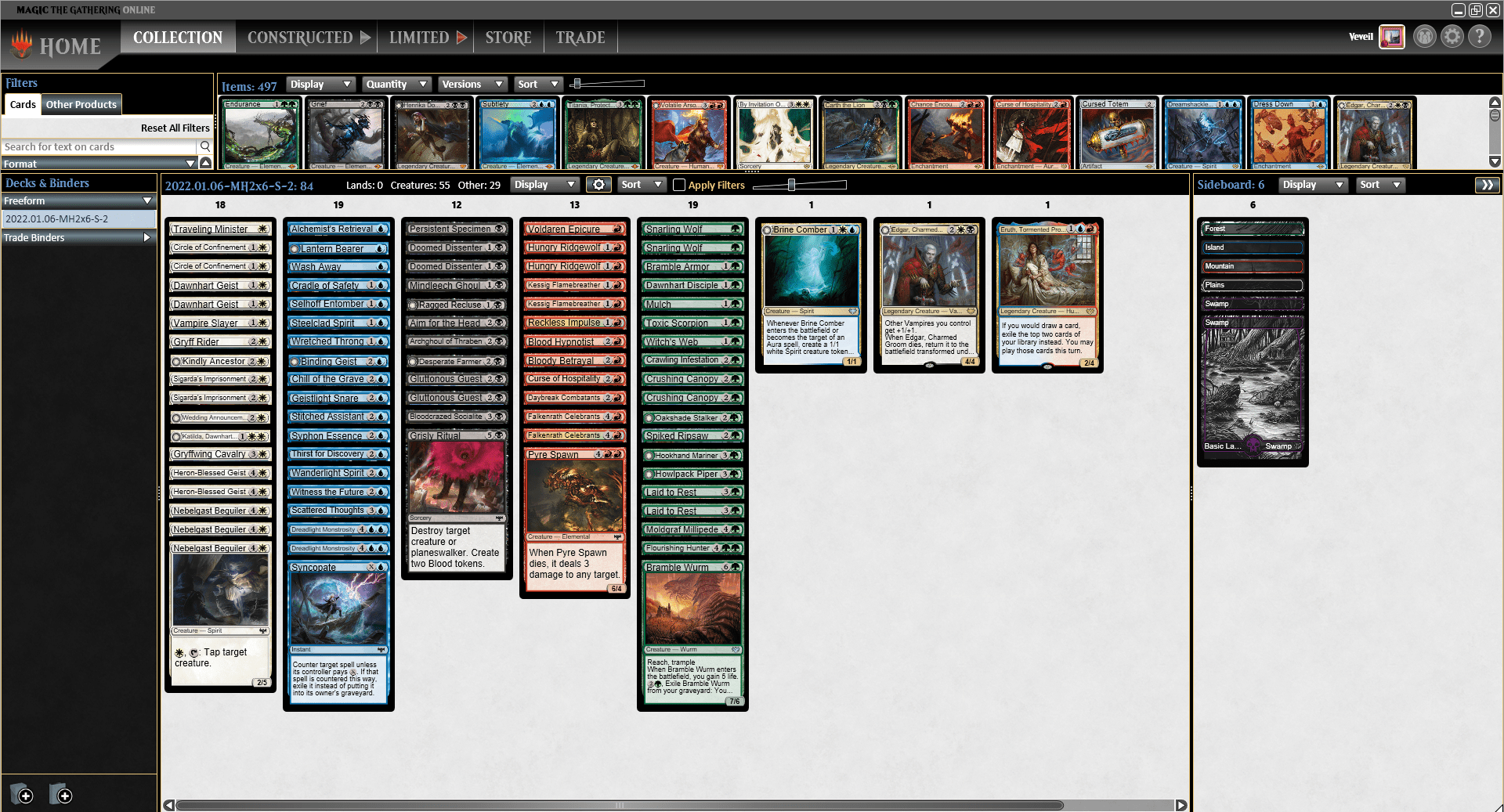
This isn’t a guide on how to build a Sealed pool but I still thought an example would work best for my explanations. This demonstrative pool has a few qualities worth examining:
- White is the best color in the pool by a solid amount. No build in this pool should realistically not be x. Wedding Announcement is a bomb and so is Katilda, Dawnhart Martyr since this pool has enough playable Spirits and enchantments to support it.
- White can be paired with any color in this pool. I looked at Orzhov (), Azorius (), and Selesnya as viable builds, though Azorius had a weird mana curve with no extra bombs.
- Being base white in this pool means being heavy on 5-drops, lacking 4-drops, and having a decent number of 2- and 3-drops. A good support color should have few good 5- and 6-drops but lots of good 2- to 4-mana value things.
- This pool has zero mana fixing so any splashes have to be very measured and mild. Edgar, Charmed Groom is the only card that really stands out as splash-worthy.
- The best draws to Orzhov are Edgar and the Ritual/Guests, the best draws to Azorius are Brine Comber and counterspells, and the best draws to Selesnya are Howlpack Piper and fatties.
- Red is the weakest color, but Falkenrath Celebrants would be great if you could play it.
And so on. I could add more bullet points, but you get the idea. Let’s use the Orzhov deck as our starting point.
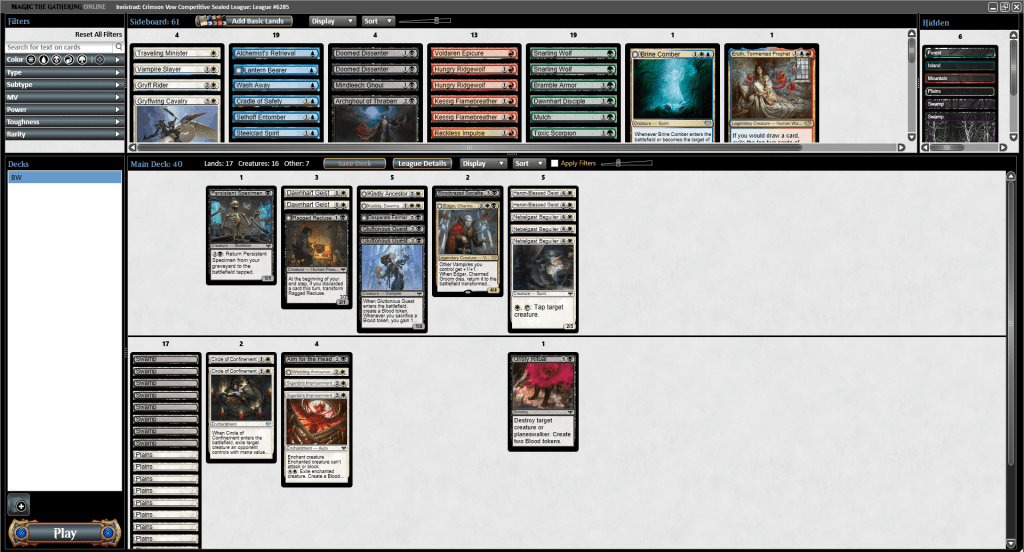
Basic Card Changes
My starting configuration for this Orzhov deck is intentionally a bit disrespectful and greedy since I don’t have all that much card advantage or late game power and want to play as much oomph as possible to compensate. I also have Katilda, Dawnhart Martyr, which is dramatically better with Spirits and enchantments and has me playing more copies of Dawnhart Geist and Nebelgast Beguiler than I'd otherwise be starting.
Sticking to just Orzhov cards, my primary sideboard cards are common creatures like Doomed Dissenter, Vampire Slayer, and Mindleech Ghoul. I could consider the tried-and-true tactic of trimming clunky expensive cards like Beguiler and Grisly Ritual for additional blockers and cheap plays when faced with an aggressive opponent.
Conversely, a slow deck could have me reaching for more flyers and cutting Persistent Specimen (mostly in for Blood value and chump blocking) and Dawnhart Geist since both cards are nearly worthless for proactive gameplay.
Adding Splashes
So the fixing isn't really adequate to splash anything without compromising our mana base with a pool like this. A 7/7/3 mana base loses about 4-8% consistency with casting its main color spells and the splash is only available by turn 5 or so about 70% of the time. My numbers are roughly derived from Frank Karsten’s invaluable math on mana consistency:

This pool also has very few cards really worth splashing. Howlpack Piper is a bomb but much stronger if played early, and I'm already starting Edgar Markov. Counterspells don't usually splash well either since I won’t necessarily be able to counter anything early if needed, potentially throwing off my curve which can snowball into a loss. Crushing Canopy is probably my favorite card here to potentially splash, but if I was going to splash it instead I might just…
Substituting Colors and Switching Decks

Play a different deck! Or at the very least a different flavor of my deck, as I’ve replaced my few black cards for green ones. Because I’m switching into this deck after game 1, I’m 100% comfortable starting with two Crushing Canopys since I played against an Azorius opponent and saw lots of flyers and enchantments.
If I wanted to switch to Selesnya in a different matchup, I could play the same deck but replace the Canopies with Toxic Scorpion and Spiked Ripsaw to stall and win the ground game.
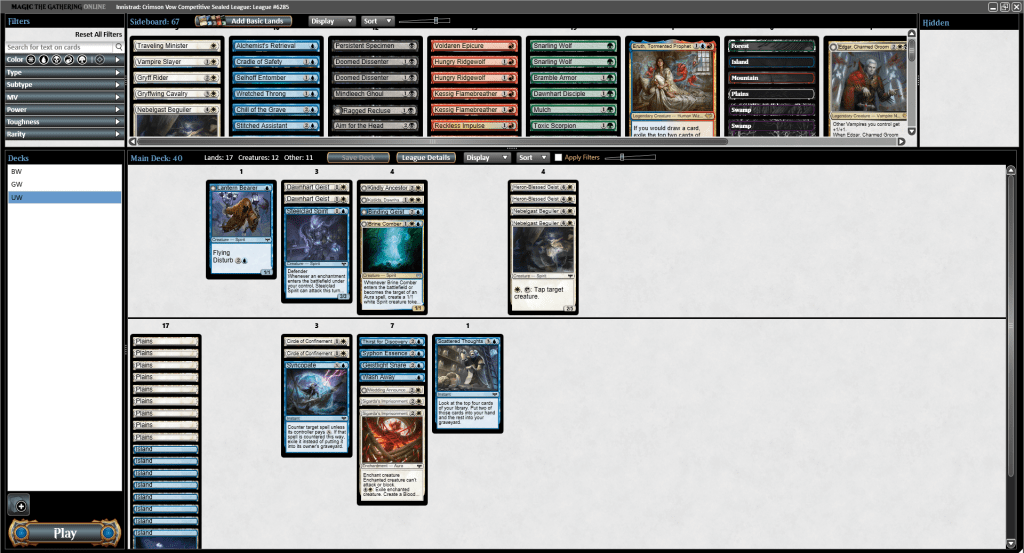
Another configuration available to me with this pool is Azorius. The primary draw is that I have four different counterspells and two instant card draw spells. This would be a very strong configuration against an opponent leaning on a few late game haymakers like Dreadfeast Demon since I have a multitude of solid ways to answer it if I’m not too behind on board. But the clunkiness and middling card quality of Azorius doesn't particularly impress me against a more balanced deck since I have 11(!) 3-mana plays.
Tips on Switching Decks
On Magic Online, switching decks is easiest if you prepare. Prebuild any viable decks you can think of and save them for easy access in Sealed Leagues. In Sealed PTQs you can open a new copy of your pool in “Freeform” under the Collection/Decks & Binders tab and then build a new deck between rounds. Once you're in game 2 or 3, right-click anywhere and then click “Import deck” and load up your new configuration. Make sure to have basic lands pre-included for an easy time!
On MTG Arena, you need to click quickly to do this since you can't save other deck configurations. No, there is no way to import a sealed deck on the client. Immediately remove your basic lands and unwanted cards and color and then quickly assemble your pre-planned deck. Don’t worry about choosing nice-looking basic lands if you're low on time.
In paper Magic, there are a few ways to try to conceal that you're switching decks. You can pre-sleeve your secondary deck or color and lump your starting deck into it, rebuilding a new 40 on the spot and hiding how much you are changing from your opponent. You can also do this and change zero cards to play mind games if you want to try and make your opponent think you're switching to a much faster or slower deck. You're basically tipping your opponent off that you're switching decks 100% of the time if you don’t do this since sleeving 10+ new cards and running off to grab basic lands isn’t exactly transparent!
Draft-Specific Tips

Updraft Elemental | Illustration by Raf Sarmento
When to Draft Sideboard Cards?
As with most things draft, the right answer on when to draft sideboard cards is “it depends.” In BO1 Arena, cards like Plummet, Return to Nature, and Crushing Canopy are unplayable or nearly so and are best ignored. In Drafts relating to this subject matter, you want to ask yourself a few quick questions:
- What's the opportunity cost of taking this sideboard card? Am I giving up something vital to my deck, or a filler card?
- If the card I’m giving up is filler, how much filler do I currently have? Most modern draft sets are very deep on playables, so taking Crushing Canopy over filler like Vampire Slayer is fine in theory. But definitely consider your mana curve first.
- Does this sideboard cover any bases I struggle with? While no drafter will refuse a free Plummet effect, a Golgari () drafter with lots of fat ground creatures would be disproportionately interested.
- With regards to Naturalize-style effects, are there common Pacifisms like Sigarda's Imprisonment and Fear of Death that you'd want to blow up? Or maybe busted rares like Ethereal Absolution, Glorious Sunrise, or Nettlecyst?
As always with specific draft picks, the right choice is always determined by opportunity cost and overall strategy. Asking yourself these kinds of questions will keep you on the right track.
General Draft Sideboarding Advice
Much of the strategy from sideboarding in Sealed remains the same in Draft, but your options are almost always going to be substantially more limited. Expect to make mostly small changes like adding more 2-drops, card draw spells, or specific removal spells for cards that don't match well against your opponent’s cards. The cards you take out are often creatures with poor sizing against your opponents, removal spells with few good targets (sometimes including generally good cards like Flame-Blessed Bolt), card draw on the draw, etc.
Knowing the basic draft archetypes for the set you're playing is an important shortcut for knowing how to sideboard against the average opponent. Most sets have very clearly defined archetypes that certain cards excel or falter against. To give some Crimson Vow examples:
- With its focus on enchantments and flyers, Crushing Canopy clearly shines against Azorius. Reach creatures and additional removal also shine and cards cheap ground blockers like Toxic Scorpion trade poorly with cheap disturb cards.
- Gruul leans on big ground-based werewolves, making deathtouchers like Toxic Scorpion and Diregraf Scavenger more effective than usual.
- Boros’s signature uncommon (Markov Waltzer is a strong flying creature, and there are a few other compelling reasons to be in this set. Canopy and reach creatures are naturally appealing against the average Boros deck.
- Vampire Slayer is a soft hate card for the average Rakdos () deck since they tend to be very heavy on vampires. It’s not a strong enough card to overpower the deck or anything, but it can still trade up with cards like Wedding Security and Falkenrath Celebrants.
- Dimir Exploit is more vulnerable to counterspells and cheap exiling removal than the average deck since most of its payoffs are clunky and need setup that can't be proactive on its own (e.g., Doomed Dissenter and Biolume Egg). You can either counter their exploit fatties on the stack or safely remove their fodder before they can sacrifice it.
There are definitely more levels to Draft than just boarding against stock decks, so you should always pay close attention to your opponent’s specific deck and cards. For instance, I mentioned Toxic Scorpion in the Gruul example as a generally solid card against werewolves. A few copies of Ballista Watcher could flip this entirely since Scorpion would end up a liability in every game where you can't immediately remove Watcher.
Go Deeper
If this is a topic you are truly interested in becoming an expert on, you're in luck. Hall of Fame Magic player Seth Manfield has created an entire course on the subject.

Sideboarding is so underappreciated, but becoming an expert is a great way to start increasing your win percentage.
Wrap Up
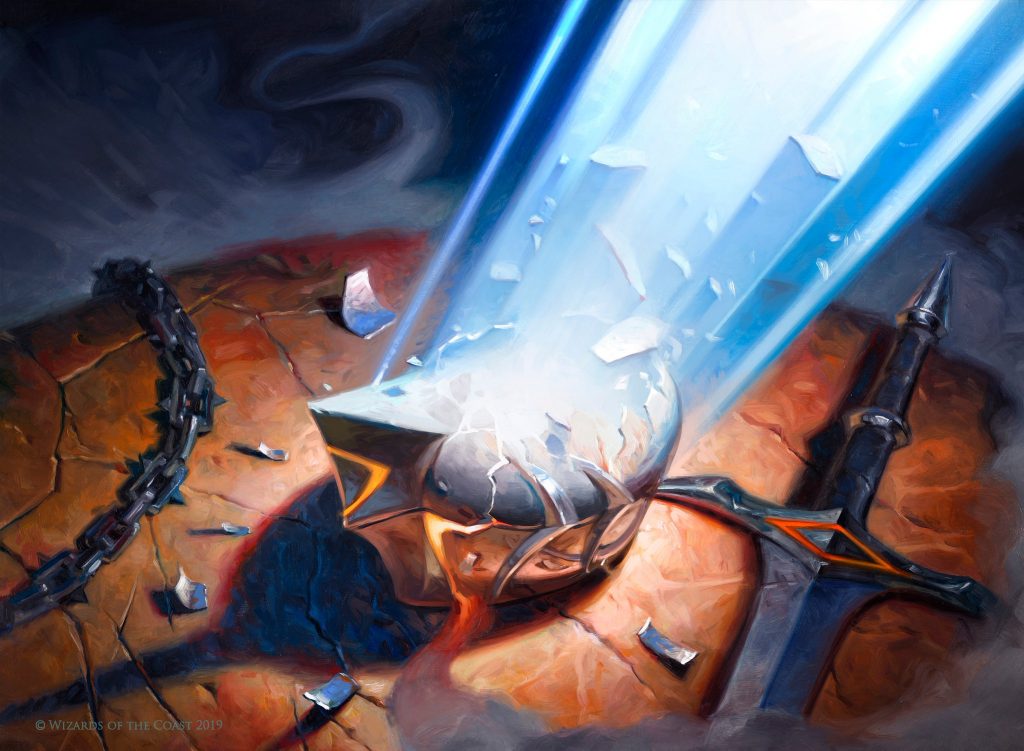
Disenchant | Illustration by Victor Adame Minguez
The operative phrase for sideboarding in Limited is definitely “it depends.” So much of playing Limited well revolves around adapting to novel circumstances in real time, and sideboarding is very much an extension of this.
If you want to improve your sideboarding, start by focusing on your available options and your reasons for each one. The mental exercise of examining different angles should bolster your acumen for playing Magic even if you don’t end up sideboarding much in the given game. The basic frame of “Plummets against flyers, Disenchants against Pacifisms and bombs that are answered by it, blockers against aggro, card draw against durdle” can also be a great starting point for adjusting your 40s on the fly.
What are your thoughts on all of this? Do you have any fun or exciting sideboarding stories? Let me know in the comments down below or find us over on the official Draftsim Discord. And if you're taking any of this advice over to MTGA, make sure you've got Arena Tutor at your side.
Until next time, may your opponents always fail to correctly sideboard against you!
Follow Draftsim for awesome articles and set updates: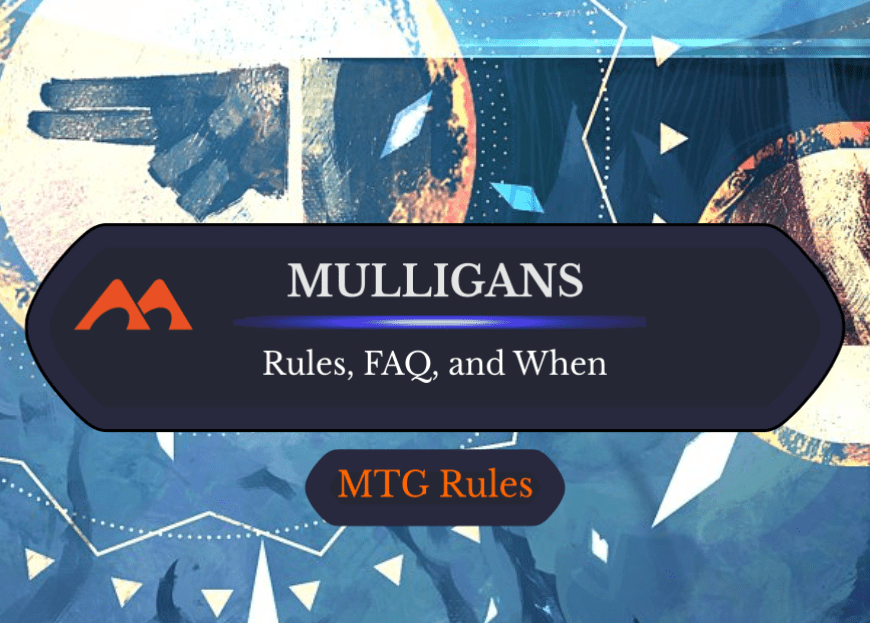
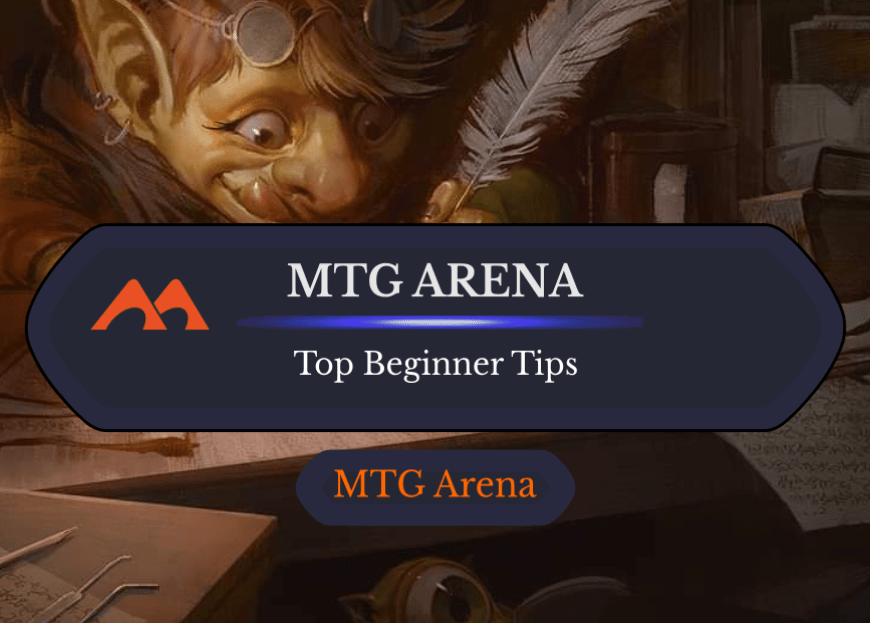
Add Comment